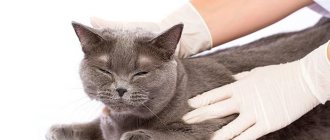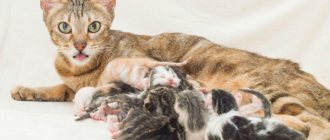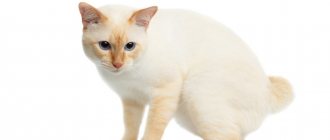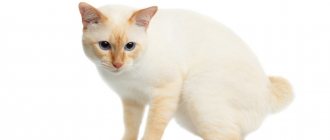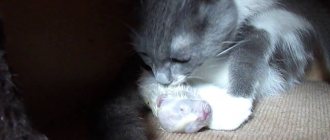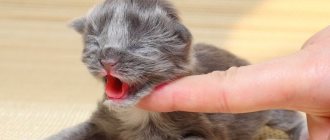7073Pavel
The cat is always the center of attention. It is impossible not to pay attention to it. Yes, she often reminds herself of herself. If a cat's tail is wet, the owner will immediately notice it.
This situation is not necessarily associated with something bad. First, you need to understand whether spilled oil or another substance is causing the problem. The cat could just get dirty. But if your tail is constantly wet, there may be several reasons.
© shutterstock
The cat's tail is wet - what should I do?
The cat is always the center of attention.
It is impossible not to pay attention to it. Yes, she often reminds herself of herself. If a cat's tail is wet, the owner will immediately notice it. This situation is not necessarily associated with something bad. First, you need to understand whether spilled oil or another substance is causing the problem. The cat could just get dirty. But if your tail is constantly wet, there may be several reasons.
Pathology or normal phenomenon?
But first, we would like to reassure overly suspicious owners: if you see that in the first days after birth a small amount of mucous or bloody discharge is released from the cat’s genital tract, then there is nothing criminal in such a phenomenon. This is the norm.
To understand why these discharges appear in the first place, you need to know a little about the physiological characteristics of the postpartum uterus. After childbirth, the organ begins to gradually recover to its original state. This process is called "involution". During this process, the remaining pieces of the placenta, excess uterine epithelium, etc. are separated. All this comes out into the external environment in the form of postpartum discharge. At first they are cloudy, but soon they become transparent and viscous.
Thus, in the first few days, when the uterine cavity is cleansing on its own, there is no need to be afraid of discharge. O can persist for about three weeks, but still, with completely normal involution, the discharge should disappear after a week and a half.
Sometimes a small amount of dried “crusts” can be seen at the root of the animal’s tail. Discharge is not normal in all cases. And the uterus itself is not always “responsible” for their appearance.
Sometimes it is necessary to urgently seek help from a professional veterinarian:
- If you miss the placenta (that is, three placentas were produced for four kittens), contact your veterinarian immediately! Retention of placenta in cats is a serious pathology, often accompanied by the development of purulent-necrotic endometritis. The treatment is difficult, long, and often requires surgical resection of the uterus.
- If excessive bloody or watery discharge appears, you should immediately contact your veterinarian, regardless of the time that has passed since birth. Such “leaks” do not mean anything good.
- Please note that any discharge you notice directly during pregnancy is always a sign of some kind of pathology.
- Infections of the genitourinary system. Bladder diseases are very dangerous (since in females the infection can quickly penetrate the uterus), as well as diseases of the uterus itself. The latter is often indicated by purulent discharge from the external genitalia of the animal.
- In addition to the previous point, we note that bladder cancer can have similar effects. Those. In this case, thick pus is released from the external genitalia, often mixed with pieces of destroyed tissue, but the uterus and other organs of the reproductive system will be fine.
- Vaginitis (inflammation of the vagina). A very common complication of protracted, difficult labor (especially in primiparous animals), accompanied by the formation of numerous ruptures in the mucous membranes of the genital organs.
- All pathologies of the blood coagulation system are extremely dangerous for cats who have given birth. If your pet has such diseases (we are talking about relatively mild cases), any wounds received during childbirth will bleed for a very long time. In severe cases, the animal will completely die from massive bleeding.
- Again, during childbirth, foreign objects may enter the vagina, resulting in injury to the genital tract.
- If a cat has enuresis (i.e. urinary incontinence), then constantly secreted urine will lead to chronic irritation of the mucous membranes and even to their inflammation. This outcome is caused (as a rule) by congenital or acquired defects of the ureters, but in cats such pathologies are quite rare in practice.
- In extremely rare cases, an open defect (fistula) may form between the rectum and vagina. An extremely severe pathology leading to no less serious consequences. It is treated exclusively by surgery. If the disease is neglected, the animal will die from sepsis or similar causes.
All these signs can (and do) only indicate serious inflammatory processes in the organs of the reproductive system.
Natural cause in cats
Your cat may have a wet tail due to the onset of the reproductive estrous cycle, popularly called estrus. A similar condition occurs in cats during sexual arousal. At this time, the animal’s body prepares for the process of mating, fertilization and pregnancy.
Estrus occurs in 4 stages:
- proestrus - takes 1-3 days, the cat attracts cats to her, but does not let them get close;
- estrus – lasts about 5 days, mating occurs;
- diestrus – 2-19 days, excitement subsides, most often pregnancy occurs;
- anestrus - sexual rest.
A discharge under the tail appears during the mating stage. At this time, the animal does not look like itself, purrs, and shows excessive tenderness. It often licks its genitals, from which a clear secretion is released. The first heat can begin at the age of 4 to 18 months, depending on the breed. What to do in this case?
There may be several options. The cat can be matched with a male, sterilized, or wait until everything goes away on its own. But for this you will have to be patient. Typically, estrus goes away within 5-15 days. If this does not happen, you should contact your veterinarian.
Pyometra
If estrus does not stop for a long time, a uterine infection may be suspected in the cat. This is a serious disease that threatens the life of the animal. It is impossible to do without veterinary control.
© shutterstock
Pyometra occurs due to hormonal changes that occur in the genital tract of a mature cat. The cause of the disease is often pregnancy that does not occur within several heat cycles. During estrus, the cervix is slightly dilated. Because of this, bacteria enter the reproductive organ. If the walls of the uterus are thickened due to unsuccessful attempts to get pregnant, bacteria begin to develop in them.
The infection manifests itself as purulent vaginal discharge. They can be noticeable under the tail, on the fur, on the bed.
If the disease is confirmed, the specialist will recommend removal of the uterus and appendages.
Anal gland problem
Cats quite often have problems associated with the excretory system . If your cat has a wound under his tail that is not related to injury, you should consult a veterinarian. It can be caused by a blockage of the sebaceous glands near the anus.
The disease is called inflammation of the paraanal glands. The secretion from the glands spreads throughout the body and leads to inflammation of neighboring tissues. An abscess appears. Left untreated, it can make it difficult for your cat to go to the toilet. Then blood poisoning occurs.
When the glands under the tail become inflamed, you may notice a discharge with a strong odor, an ulcer, a fistula, or a lump.
The problem can be treated with medications and gland cleaning. To prevent it, it is important to balance the cat’s diet and monitor the condition of the sebaceous glands. Then it won’t be wet under your tail either.
Common Causes of Inflammation
Inflammation or abscess of the paraanal glands often develops with trauma and mechanical damage to this area (for example, falls from a great height). This leads to dysfunction of the glands, disruption of the outflow of secretions and its subsequent accumulation. All this provokes the development of an inflammatory process involving pathogenic microflora.
Most often, long-haired cats living in apartments face the problem of inflammation of the paraanal glands. This is due to the fact that they lose the natural ability to cleanse the anal sacs (due to the absence of potential enemies and the need to defend themselves from them).
Common causes of inflammation of the paraanal glands:
- dysbacteriosis (for example, due to prolonged use of antibiotic drugs by the pet),
- helminthic infestations,
- eating small bones
- feeding mass market liquid food,
- lack of physical activity,
- injuries to the anus and anal area,
- disorders of the gastrointestinal tract, accompanied by frequent constipation.
Older cats are more prone to inflammation and abscess of the anal glands. One of the factors that can affect the development of the inflammatory process is that the pet’s gland channels are too narrow from birth. Veterinarians include cat pregnancy and excess weight (obesity) as additional provoking factors.
Without timely veterinary care, the animal will develop complications. The inflammatory process can quickly develop into an abscess (purulent inflammation), which poses a threat not only to the health, but also to the life of your pet. That is why, when the first signs of a problem appear, you need to contact a veterinary clinic in Moscow as soon as possible.
The kitten's tail is wet
Posted by Kotizm March 6, 2017
Having bought a small kitten, the owner often worries about its health. Any problems cause concern and a desire to help the baby. This is quite natural and commendable, as is a timely visit to the veterinarian.
Why does a kitten run after its tail and chew it, the reason and what is it
Kittens are very playful. They happily run after everything that moves in front of their nose. Having noticed his tail, the baby can chase it. However, excessive attention to the tail may indicate the presence of worms or a lack of vitamins.
Why was the kitten born without a tail, skin without a protective covering?
If the absence of hair and tail is unusual for the kitten’s breed, it means that it has a congenital pathology. It can occur due to abnormalities in intrauterine development. If a cat was given drugs during pregnancy that are teratogenic, such as griseofulvin, the kittens may be born not only without fur and a tail, but also deaf and blind, or die in the womb.
Possible pathologies
Most pathological causes are associated with inflammation and infection of the uterus. This can lead to infertility and even death. To avoid complications, it is necessary to diagnose the existing disease as soon as possible and begin its treatment.
Pyometra
The risk group includes unsterilized animals over 5 years old. Due to hormonal imbalance, pus accumulates in the uterus, so the cat develops copious brownish or cream-colored discharge. Spots of the corresponding color can be seen on the bedding and other resting places of the pet.
The most dangerous form of pyometra is closed. With this disease, the pus does not extend beyond the uterus. This is accompanied by acute pain and enlargement of the abdomen. Over time, the walls of the organ cannot withstand and become damaged. The contents spill into the abdominal cavity, causing the death of the animal.
Endometritis
If a cat's white discharge appeared shortly after birth, then placenta particles could remain in the uterus. Their rotting can provoke endometritis - inflammation of the uterine mucosa. In addition to delayed placenta, the disease can occur due to hormonal imbalance and infection of the genital organs.
The appearance of abundant mucopurulent exudate is accompanied by frequent urination, loss of milk and severe pain. An advanced form of endometritis is fraught with the development of pyometra, infertility and sepsis.
Hematometer
Scanty bleeding in a cat, accompanied by fever and cramping pain, is characteristic of hematometra. With this pathology, blood accumulates in the uterus, since it cannot pass through the endocervix (mucous membrane of the cervix). Narrowing or blockage of the cervical canal occurs due to:
- muscle spasm;
- abortion or miscarriage;
- uterine fibroids;
- congenital anomalies;
- incorrectly performed operations;
- frequent childbirth.
Accumulating blood attracts pathogenic microorganisms. Over time, this leads to purulent inflammation - pyometra.
Hydrometer
With a hydrometer, secretions produced by the uterine glands, transudate and exudate, accumulate in the uterus. If the cervical canal is open or only partially blocked, a small amount of white or clear fluid will leak from the loop. This pathology is most easily detected in a sterilized cat whose discharge is not typical.
Hydrometra is often a complication of the chronic form of endometritis. Over time, the walls of the uterus stretch and become thinner. Scarring and adhesions appear at the site of ruptures. Without timely assistance, death occurs.
Vaginitis
With vaginitis, the walls of the vagina become inflamed and covered with ulcers. The catarrhal-purulent form of the pathology is complicated by an abscess. A sick cat develops a viscous white discharge that resembles thick cream.
The main causes of the disease are a sharp decrease in immunity and postpartum vaginal trauma. Opportunistic bacteria (Escherichia coli, streptococci, staphylococci) living in the body are activated and cause infection.
Other diseases
In addition to the listed diseases, bleeding, copious mucus and pus can be a symptom of several other pathologies. These include:
- Malignant tumors
. Blood appears not only in mucus, but also in urine and feces. As the condition worsens, pus is released. Oncology often occurs due to hormonal imbalances caused by taking drugs to suppress desire. - Blood clotting disorder
. Hematological pathology is accompanied by the appearance of scarlet liquid or clots. - Vaginal phlegmon
. Inflammation affects the subcutaneous fat of the vulva. Due to the gradual growth of the organ, abscesses appear. The pus coming out of the vulva has a mucous consistency. - Uterine trauma
. The appearance of scarlet blood shortly after sterilization is a complication caused by careless surgical intervention. In this case, it is better to call a veterinarian at home, since transporting the animal can aggravate its condition. - Placental abruption or decomposition
. When placental abruption occurs, brown clots appear from the loop. If the kittens die in the womb, the color changes to green. Decomposition adds a strong, unpleasant odor. Bleeding may also occur. If these symptoms occur, you must urgently contact a doctor to prevent the death of the animal.
To identify a possible cause, it is necessary to take into account all accompanying symptoms. If the pet is active, eats well and takes care of the kittens, then you don’t have to worry about her.
Wet tail (colibacillosis)
Colibacillosis is an infectious disease accompanied by enteritis, also known as “wet tail”. Causes pathology E. coli. Normally, E. coli is present in the animal’s body, but under certain circumstances the number of bacteria can exceed the norm, resulting in disease.
It is assumed that the infection is transmitted through household items, through contact of a sick animal with a healthy one, and through airborne droplets.
Most often, hamsters, rats and mice suffer from the disease; Rabbits, guinea pigs and larger rodents get sick less often.
Reasons for behavior
Cats constantly lick themselves for the following reasons:
- Fleas.
- Ticks.
- Allergy, the animal licks itself, scratches its lips and nose. Seasonal irritation or reaction to foods or other items occurs.
- The microflora that lives on the skin, bacteria and fungus, appears even in healthy kittens due to vitamin deficiency, nervous stress, and weakness of the body. Due to inflammation and itching, health worsens. Microbes are transmitted through people and enter the gastrointestinal tract of pets, who always lick their lips.
- Infectious diseases appear after interaction with contaminated surfaces or other living creatures. Distributed: cheyletiellosis, scabies, pyodermatitis, demodicosis.
- Hormonal disorders cause all of the above symptoms; problems with the endocrine system are treated with diet.
- Otitis - an infection appears in the ears, sometimes pus is released, the sick animal itches, shakes its head, rubs its muzzle strongly against hard objects, and the skin is scratched.
When cat skin diseases appear, owners regularly wash their hands and strictly observe the rules of personal hygiene so that germs do not spread.
They often lick themselves after castration; this is a natural necessity. After a surgical procedure, your pet instinctively tries to lick the wounds until the stitches close. The blanket is placed around the neck to prevent complications and is removed after 10 days.
Types of allergies:
- Food often causes itching; the allergen is determined by the method of one by one eliminating foods from the diet.
- Contact is diagnosed after excluding food. Pathogens: plant pollen, room fresheners, household chemicals.
- Medicinal. Vaccinations or pills are canceled, dermatitis goes away on its own.
When stressed, they do not stop licking, they often itch, and their fur sometimes falls out. The veterinarian determines the cause of abnormal behavior, and moderate use of sedatives helps.
Types of hormonal disorders:
- Pathologies of the thyroid gland and other disorders of the endocrine system, hyperthyroidism provokes baldness, itching, flaking of the skin.
- Cushing's syndrome, which affects the functions of the adrenal glands, causes alopecia, comedones occur, the epidermis becomes flabby, and is easily scratched.
- With diabetes, the color of the coat becomes dull, the skin dries out, seborrheic dermatitis and baldness develop.
Skin diseases:
- With ringworm, hair falls out and round bald patches appear. The disease is more severe in people after infection and requires rapid treatment.
- Ringworm, a fungus on wool and skin, is harmless to humans.
Pyoderma is a complex bacterial infection with the following consequences:
- Baldness.
- Suppuration.
- Cats itch and meow all the time.
The disease affects animals of any breed.
Symptoms
Watery diarrhea, which leads to the characteristic “wet tail” symptom. However, loose stools appear last: initially, there is a lack of appetite and lethargy.
The incubation period of the disease is about 5-7 days.
Diarrhea does not always mean colibacillosis. Sometimes loose stools in an animal occur due to stress, changes in diet, and other “harmless” factors. Any diarrhea is a cause for concern, so you should contact your veterinarian at the first sign of it.
What does white discharge mean?
The appearance of white discharge from the anus and organs of vision is always alarming, since in most cases the color change is associated with the presence of pus and inflammation. If mucus was found on the loop, this may be normal.
Pathological changes in the body
The presence of white discharge may indicate the following pathologies and abnormalities:
- Infectious diseases of the genitourinary system. White or yellow discharge from the urethra may be associated with infection with chlamydia, toxoplasmosis, mycoplasmosis, etc. The mucus in most cases has an unpleasant odor. Sometimes there are no symptoms. Infection most often occurs during mating, so you should carefully select a partner for your cat.
- Pyometra. It is characterized by the presence of an inflammatory process with abundant formation of pus. There are several types of pyometra. If a cat's white discharge gradually comes out of the loop, this is an open form. It is easier to diagnose and treat. In the closed form, the discharge does not leave the uterus, which leads to its rupture and the further development of sepsis. Such pyometra is not always detected on time, since many owners mistake an enlarged abdomen and symptoms of intoxication for pregnancy.
- Oncology. Tumors occur more often in older cats. They cause white discharge from the urethra or anus. If the tumor is located in the intestinal lumen, its individual fragments may be present in the stool. In the early stages, cancer is asymptomatic, but later common symptoms appear: refusal to eat, anxiety, weight loss, etc.
- Development of complications after surgery. In such cases, the appearance of white discharge is associated with tissue infection. Most often, repeated surgery is required to eliminate the consequences. If you do not help the animal, the infection will develop rapidly.
- Vaginitis. Characterized by inflammation of the mucous membranes of the vagina. In most cases, the disease is asymptomatic, but some cats experience copious clear or whitish discharge. The animal experiences discomfort and often licks itself, trying to alleviate the condition.
- Phlegmon. Inflammation occurs, accompanied by the formation of abscesses. Mucus mixed with pus comes out of the urethra. The animal experiences pain and the temperature rises due to inflammation.
- Pathologies of the organs of vision. Most often, the appearance of whitish mucus from the eyes is caused by infections. They can develop independently or as a result of injury. The discharge is accompanied by redness of the protein, inflammation of nearby tissues, itching, the appearance of crusts, etc.
- Cystitis. Cystitis. Often has an infectious nature of origin. First, the animal experiences problems with urination. When the mucous membranes are damaged, blood first appears in the urine, and later pus, which is excreted only in the urine.
- Kidney diseases. These include pyelonephritis, glomerulonephritis, urolithiasis, etc. If internal tissues are damaged due to inflammation, microbial activity, or injury from stones, pus and blood appear in the urine.
- Gastrointestinal pathologies. In diseases of the stomach, intestines, pancreas and liver, discharge is found in the stool. In the initial stages it is clear mucus, later it becomes white and blood is added. In advanced cases, neighboring organs may become inflamed, and then discharge from the loop may appear.
- Inflammation of the anal glands. Accompanied by the appearance of purulent discharge from the anus and in the feces. The animal licks the anal area and can move its butt on the floor. Due to the discharge, the fur near the tail becomes wet. In advanced cases, fistulas form, from which pus comes out.
- Parasites. Most often, discharge appears in the stool. This happens due to worms. In feces you can sometimes find not only mucus, but also worms or their fragments. If the infection is severe, the cat begins to vomit, the hair falls out and becomes dull.
Treatment
Antibacterial drugs are used
- tetracycline orally (dilute 0.3 g per 100 ml of water, check dosage with your veterinarian),
- subcutaneous injection with chloramphenicol (5 mg of the drug per 100 g body weight),
- Oral solution of metronizadol (1 tablet per 200 ml of water, give 1 ml per 350 g of live weight).
There is evidence of successful treatment of “wet tail” with Nifuroxazide (Ersefuril); by the way, this drug, like the other antibacterial agents listed above, is sold in regular pharmacies (they give 1 drop per 100 g of weight, 2-3 times a day).
Vaseline oil will reduce the irritating effect of toxins on the gastrointestinal tract (dosage: 2 drops per 50 g of weight).
You can give Linex and other similar drugs to restore normal intestinal microflora.
No-spa and papaverine will help reduce painful spasms (the dose is determined by the doctor). Medicines are soldered from a syringe without a needle or a small syringe.
To improve the condition of the animal and provide additional nutrition, you can inject glucose. Injections are administered 2-3 times a day to the withers area at the rate of 1 ml of 5% glucose solution per 100 g of animal body weight. Feeding with saline solution (0.9% sodium chloride) is also indicated.
Associated symptoms
Bleeding can manifest itself as an independent symptom or manifest itself as a number of accompanying signs, including:
- plaintive meow;
- increased body temperature, especially during inflammatory processes;
- bloating;
- pain when urinating;
- blood impurities in stool;
- change in urine color to a brownish-red hue.
All of the above signs indicate clear signs of disease. In this case, treatment should be prescribed exclusively by a veterinarian. Therapy must include antibiotics, anti-inflammatory, antispasmodic, and painkillers. If urolithiasis is diagnosed, then surgery is performed to remove the stones. Uterine diseases in cats can be treated with special medications or sterilization. In any case, if characteristic symptoms are detected, the breeder should contact a specialist to prescribe effective treatment.
Prevention, advice to owners
In the treatment and prevention of “wet tail”, it is important to follow the rules of hygiene - clean the cage in a timely manner, replace food and water daily, wash your hands after interacting with animals (since the infection is easily transmitted from one rodent to another).
If several animals are kept in one cage, then the sick should be immediately isolated and the cage should be thoroughly cleaned.
Further care should begin with healthy pets, and then only carry out hygiene procedures on sick animals.
It is not advisable to keep a sick pet in the same room as healthy ones.
Several times a day, the cage of a sick rodent is disinfected with antiseptics and the bedding is changed - these actions help to avoid re-infection.
Kinds
A fistula on a cat's neck, cheeks, paws or tail is usually purulent. It exudes ichor and suppuration, and has an unpleasant but not pungent odor. The wound is clearly visible. If you consult a doctor immediately upon detection of the disease, the prognosis will most likely be favorable.
Fecal fistulas often appear on the abdomen, near the anus. They are more difficult to notice; often the owner becomes aware of the problem due to the appearance of a sharp unpleasant odor. Not only pus and ichor are visible in the wound, but also feces and urine. The risk of infection of damaged tissues of the body surface or internal organs increases. Longer treatment and the use of potent drugs are required. Failure to contact a veterinarian in a timely manner can lead to the death of the animal.
The course of the disease and the prognosis for cure depend on the structure of the fistula. With granulation holes, the walls of the canal are affected and become loose, which contributes to the spread of infection. In epithelialized ones, the canal is smooth, hair falls out around the wound, tissues become inflamed, in labiform ones, a channelless hole appears, directly connected to an internal organ or anatomical cavity.
Prevention of cats with hypersalivation
Drooling from the mouth in cats is called hypersalivation. Prevention is necessary to prevent the disease.
- From an early age, a kitten should be taught to brush its teeth and tongue.
- For fleas, special drops should be made so that they fall on the withers as far as possible from the possibility of licking off this product with the tongue.
- A visit to the veterinarian will help avoid pathological drooling.
If there is hypersalivation for no reason, you should consult a veterinarian. Even if the cat is in excellent health, the presence of excessive drooling indicates problems in the body. Therefore, only a doctor can make an accurate diagnosis and prescribe treatment.
Should you worry if one day you notice your pet has dripping saliva, a wet chin and wet fur on his chest? Yes. Because
Cats should not normally drool
Drooling, also known as ptyalism, also known as hypersalivation, also known as sialorrhea, is an increase in the function of the salivary glands, that is, increased formation of saliva.
First of all, this is a symptom of nausea, which, in turn, is a symptom of many things (poisoning, infectious or systemic diseases, etc.).
It can also be caused by nervous disorders, inflammation of the oral cavity, foreign body, or dental problems.
The most alarming drooling causes:
- rabies
Drooling caused by a “non-anxious” reason is usually short-lived. If it is abundant and prolonged, for no apparent reason or is accompanied by other symptoms, this is certainly a reason to visit the veterinary clinic.
1. The cause of hypersalivation often lies directly in the mouth, since the inflammatory processes of the gums and teeth, causing pain, interfere with swallowing, and the mouth becomes full of saliva. Therefore, when we notice inexplicable drooling in a pet, we first look into its mouth.
The presence of ulcers and red spots in the oral cavity, especially in combination with other symptoms, for example, discharge from the eyes, anorexia, lethargy, suggests a viral disease (even if the cat is vaccinated!) - we go to the doctor.
From veterinary forums:
In case of inflammation of the gums, problems with the teeth, a hard-to-reach foreign body (for example, a deeply stuck bone), which may be accompanied by bad breath, bloody saliva, difficulty eating or refusing to eat, pawing of the muzzle, we go to the doctor.
2. Drooling followed by vomiting (lethargy, weakness, muscle tremors) may mean poisoning with poor-quality products, household chemicals, insecticides (poisoning can also occur when licking the paws after contact with chemicals), plants dangerous to the cat - we go to the doctor. Poison, rat poison - we rush to the doctor at full speed.
3. Nausea and vomiting can be caused by diseases of internal organs, neoplasms, etc. - we go to the doctor and get a diagnosis.
4. Overheating (in the heat, high body temperature, lethargy, shortness of breath) - start cooling and go to the doctor
5. Drooling + behavior change + lack of vaccinations = thought: is this rabies? About this terrible disease -.
6. Sometimes the anxiety or fear that causes excessive drooling is so severe that it also requires veterinary attention.
Treatment of drooling is treatment of the cause that caused it.
